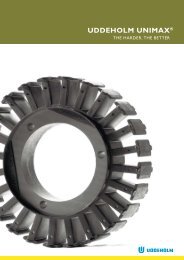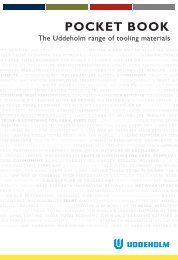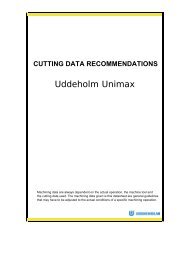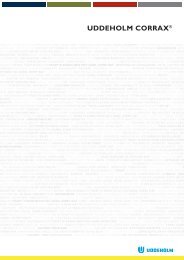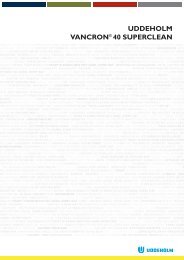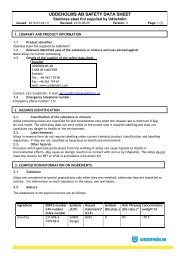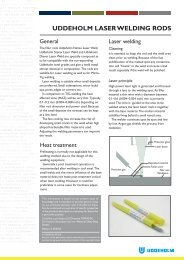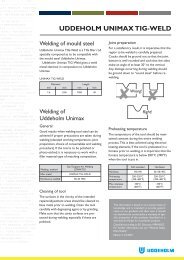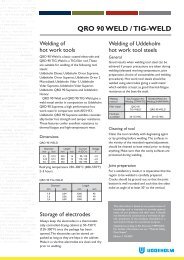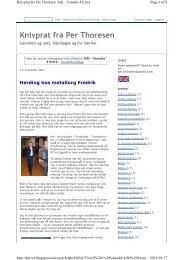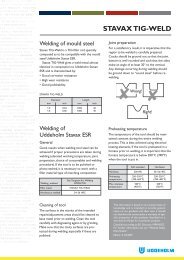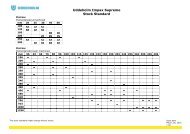UDDEHOLM ORVAR 2 MICRODIZED
UDDEHOLM ORVAR 2 MICRODIZED
UDDEHOLM ORVAR 2 MICRODIZED
You also want an ePaper? Increase the reach of your titles
YUMPU automatically turns print PDFs into web optimized ePapers that Google loves.
<strong>UDDEHOLM</strong> <strong>ORVAR</strong> 2 <strong>MICRODIZED</strong><br />
Tempering<br />
Choose the tempering temperature according<br />
to the hardness required by reference to the<br />
tempering graph. Temper minimum twice with<br />
intermediate cooling to room temperature.<br />
Lowest tempering temperature 250°C (480°F).<br />
Holding time at temperature minimum 2 h.<br />
To avoid “temper brittleness”, do not temper<br />
in the range 425–550°C (800–1020°F), see<br />
graph.<br />
DIMENSIONAL CHANGES DURING HARDENING<br />
Sample plate, 100 x 100 x 25 mm, 4” x 4” x 1”.<br />
Width Length Thickness<br />
% % %<br />
Oil hardened from min –0.08 –0.06 0.00<br />
1000°C (1870°F) max –0.15 –0.16 +0.30<br />
Air hardened from min –0.02 –0.05 ±0<br />
1020°C (1870°F) max +0.03 +0.02 +0.05<br />
Vac hardened from min +0.01 –0.02 +0.08<br />
1020°C (1870°F) max +0.02 –0.04 +0.12<br />
TEMPERING GRAPH<br />
Hardness, HRC<br />
60<br />
Austenitizing<br />
temperature<br />
1050°C (1920°F)<br />
55<br />
50<br />
45<br />
40<br />
35<br />
30<br />
1020°C<br />
(1870°F)<br />
1025°C<br />
(1875°)<br />
Retained austenite<br />
Retained austenite %<br />
6<br />
4<br />
2<br />
DIMENSIONAL CHANGES DURING TEMPERING<br />
Dimensional change %<br />
+0,12<br />
+0,08<br />
+0,04<br />
0<br />
-0,04<br />
-0,08<br />
-0,12<br />
100 200 300 400 500 600 700°C<br />
210 390 570 750 930 1110 1290°F<br />
Tempering temperature (1h + 1h)<br />
Note: The dimensional changes in hardening and<br />
tempering should be added.<br />
25<br />
Tempering within the range 425–550°C (800–<br />
1020°F) is not normally recommended due to<br />
the reduction in toughness properties.<br />
Hardness, HRC<br />
58<br />
54<br />
50<br />
46<br />
42<br />
38<br />
34<br />
30<br />
100 200 300 400 500 600 700°C<br />
210 390 570 750 930 1110 1290°F<br />
Tempering temperature (2h + 2h)<br />
Above tempering curves are obtained after heat treatment of<br />
samples with a size of 15 x 15 x 40 mm, cooling in forced air.<br />
Lower hardness can be expected after heat treatment of<br />
tools and dies due to factors like actual tool size and heat<br />
treatment parameters.<br />
EFFECT OF TIME AT TEMPERING TEMPERATURE<br />
500°C<br />
(930°F)<br />
550°C<br />
(1020°F)<br />
Austenitizing<br />
temperature<br />
1020°C (1870°F) 600°C<br />
(1110°F)<br />
1 1.5 2.5 4 6.5 10 15 25 40 65 100 400<br />
Total holding time at tempering temperature, hours<br />
Nitriding and nitrocarburizing<br />
Nitriding and nitrocarburizing result in a hard<br />
surface layer which is very resistant to wear<br />
and erosion. The nitrided layer is, however,<br />
brittle and may crack or spall when exposed<br />
to mechanical or thermal shock, the risk increasing<br />
with layer thickness. Before nitriding,<br />
the tool should be hardened and tem-pered at<br />
a temperature at least 25–50°C (45–90°F)<br />
above the nitriding temperature.<br />
Nitriding in ammonia gas at 510°C (950°F)<br />
or plasma nitriding in a 75% hydrogen/25%<br />
nitrogen mixture at 480°C (895°F) both result<br />
in a surface hardness of about 1100 HV 0.2 . In<br />
general, plasma nitriding is the preferred<br />
method because of better control over nitrogen<br />
potential; in particular, for-mation of the<br />
so-called white layer, which is not recommended<br />
for hot work service, can readily be<br />
avoided. However, careful gas nitriding can give<br />
perfectly acceptable results.<br />
Uddeholm Orvar 2 Microdized can also be<br />
nitrocarburized in either gas or salt bath.<br />
The surface hardness after nitrocarburizing is<br />
900–1000 HV 0.2 .<br />
6




